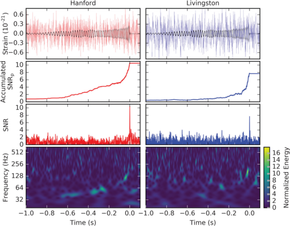|
GW151226
GW151226 was a gravitational wave signal detected by the LIGO observatory on 25 December 2015 local time (26 Dec 2015 UTC). On 15 June 2016, the LIGO and Virgo collaborations announced that they had verified the signal, making it the second such signal confirmed, after GW150914, which had been announced four months earlier the same year,[1][2] and the third gravitational wave signal detected. Event detectionThe signal was detected by LIGO at 03:38:53 UTC, with the Hanford detector picking it up 1.1 milliseconds after the Livingston detector (since the axis between the two was not parallel to the wave front); it was identified by a low-latency search within 70s of its arrival at the detectors.[1] Astrophysical originAnalysis indicated the signal resulted from the coalescence of two black holes with 14.2+8.3 In this second detection, LIGO Scientific Collaboration and Virgo scientists also determined that at least one of the premerger black holes was spinning at more than 20% of the maximum spin rate allowed by general relativity.[1][4] The final black hole was spinning with 0.74+0.06 The location/direction in the sky is poorly constrained. The signal was first seen at Livingston with delay of 1.1 (±0.3) ms later at LIGO Hanford.[1] ImplicationsThe GW151226 event suggests that there is a large population of binary black holes in the Universe that will produce frequent mergers.[6] The measured gravitational wave is completely consistent with the predictions of general relativity for strong gravitational fields. The theory's strong-field predictions had not been directly tested before the two LIGO events. General relativity passed this most stringent test for the second time.[3][7] See alsoReferences
External links |
||||||||||






